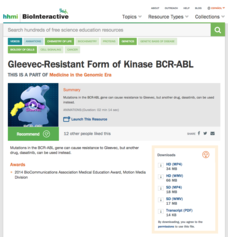FuseSchool
What Are White Blood Cells?
White blood cells are our body's tiniest warriors! How do they work? Biology scholars discover the types and functions of white blood cells through a video from an intriguing biology playlist. The resource profiles both types of white...
Curated OER
What is Blood?
When we speak of blood, we are usually talking about several different components that make up blood. Do you know what blood consists of? This informative video explains the three elements of blood as well as the nutrients in plasma. The...
FuseSchool
Intro to Cells: Animal, Plant, Nerve and Red Blood Cells
Throw your dendrites in the air and wave 'em like you just don't care! An excellent video in the Fuse School playlist explains the parts and functions of cells. It describes their structures, functions, and specialties.
Curated OER
The Circulatory System
Compare a variety of animals' circulatory systems to the human circulatory system. Paul Andersen uses his SMART Board to show the differences between two, three, and four chamber hearts, focusing on the human heart.
TED-Ed
How Bones Make Blood
Bones are blood cell factories. Viewers learn all about bone marrow and how blood cells produced in the marrow of a donor can be grafted into a cancer patient to fight the disease.
FuseSchool
What Is Blood?
Blood makes up approximately seven percent of the weight of each human, but what is blood? As part of the Fuse School Biology playlist, the video describes the four components of blood. It offers descriptions of what they look like as...
American Chemical Society
What's the Deal with Acne?
Use science to treat acne outbreaks! Scholars learn the immune response that creates their dreaded pimples. An ACS Reactions video lesson explains how bacteria and white blood cells interact to create these blemishes and how hormones...
TED-Ed
What Is Leukemia?
Leukemia afflicts children more than any other type of cancer. Pupils explore the nature of harmful mutations in cell DNA, the reproduction of damaged cells in blood and bone marrow, and their effect on normal functions of the human body.
FuseSchool
Human Defense Systems Against Pathogens
With so many harmful agents around us, how do humans stay healthy? Find out by watching an informative video from a larger biology playlist that details our defenses against a variety of pathogens. The narrator describes the body...
Bozeman Science
Immune System
Flu vaccines work by calling on the immune system to produce antibodies against the virus without actually infecting the individual with the flu. Here class members see how a virus enters cells and the body defends itself. The instructor...
FuseSchool
What Are Vaccinations?
Are vaccinations necessary in preventing illness? As part of a larger playlist, a short, yet informative video describes what vaccines are and how they work in the body. Viewers witness the introduction of the vaccine culture and how the...
Be Smart
Could You Be Immune to Everything?
Could super immunity be the next big super power? Discover the amazing inner workings of the immune system through an engaging video from an interesting science playlist. Animated antibodies take on a variety of pathogenic invaders while...
TED-Ed
How a Wound Heals Itself
Did you know that the biggest organ in the human body isn't the brain, the liver, or even the lungs? It's the skin. Follow along with this short video as it explores the structure of human skin and its amazing ability to regenerate itself.
TED-Ed
Why it's so Hard to Cure HIV/AIDS
Believe it or not, a man was cured of HIV in 2008; unfortunately doctors are still scratching their heads trying to figure out how it happened. Follow along with this short video to learn about this deadly virus and the unique...
American Chemical Society
The Science of the Avengers
Are superheroes science fiction ... or just really fancy science? Go even further behind the scenes with the characters from Avengers through a video from the American Chemical Society's Reactions playlist. Curious chemists learn the...
Howard Hughes Medical Institute
The Birth and Death of Genes
Notothenioids are not your average fish—they contain antifreeze! An interesting video introduces the icefish, a scaleless fish with colorless blood that lives in the oceans around Antarctica. It explains how gene duplication and...
Howard Hughes Medical Institute
Gleevec Inhibits Cancer-Causing Kinase BCR-ABL
Less than 30 percent of those diagnosed with acute myeloid leukemia live for five years. One researcher shares a breakthrough in treatment for this specific type of cancer. He explains how it spreads and how the medication prevents the...
Howard Hughes Medical Institute
Gleevec-Resistant Form of Kinase BCR-ABL
Gene mutation occurs at a rate much higher than many realize. Doctors treating cancer and other illnesses must learn to adapt quickly after each mutation. Viewers observe an animation and watch lecture with props to see what happens when...
Be Smart
Why Vaccines Work
Vaccines were first used in 1796, about 100 years before viruses were even discovered. Beginning with the history of scurvy and polio, viewers see how vaccines work and how they help humans overcome and eradicate diseases.
Other popular searches
- Red & White Blood Cells
- White Blood Cells Video
- Leukocytes/white Blood Cells
- Red and White Blood Cells




















